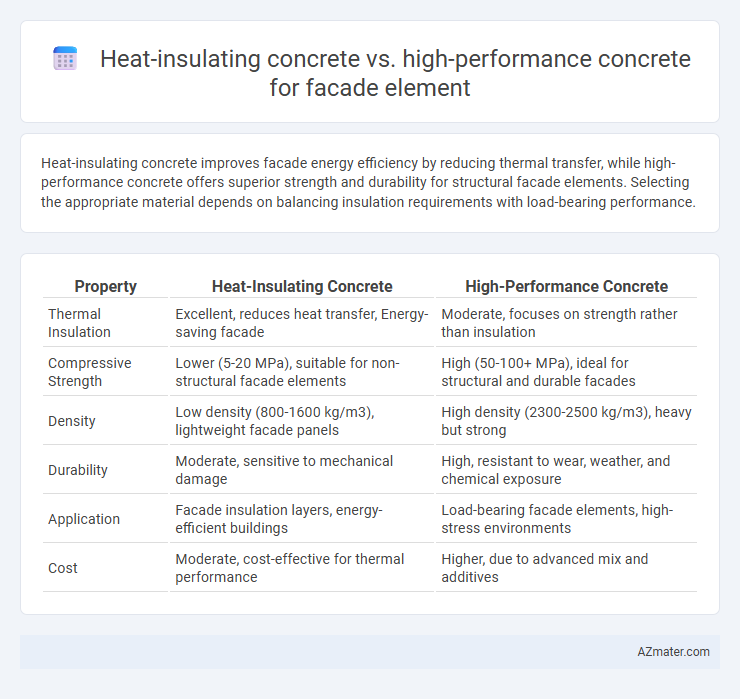Heat-insulating concrete improves facade energy efficiency by reducing thermal transfer, while high-performance concrete offers superior strength and durability for structural facade elements. Selecting the appropriate material depends on balancing insulation requirements with load-bearing performance.
Table of Comparison
| Property | Heat-Insulating Concrete | High-Performance Concrete |
|---|---|---|
| Thermal Insulation | Excellent, reduces heat transfer, Energy-saving facade | Moderate, focuses on strength rather than insulation |
| Compressive Strength | Lower (5-20 MPa), suitable for non-structural facade elements | High (50-100+ MPa), ideal for structural and durable facades |
| Density | Low density (800-1600 kg/m3), lightweight facade panels | High density (2300-2500 kg/m3), heavy but strong |
| Durability | Moderate, sensitive to mechanical damage | High, resistant to wear, weather, and chemical exposure |
| Application | Facade insulation layers, energy-efficient buildings | Load-bearing facade elements, high-stress environments |
| Cost | Moderate, cost-effective for thermal performance | Higher, due to advanced mix and additives |
Introduction to Facade Concrete Technologies
Heat-insulating concrete integrates lightweight aggregates and thermal additives to reduce heat transfer, enhancing energy efficiency in building facades. High-performance concrete (HPC) is characterized by its superior strength, durability, and enhanced mechanical properties, making it ideal for structurally demanding facade elements. Both technologies address specific facade requirements, with heat-insulating concrete primarily targeting thermal regulation and HPC focusing on load-bearing capacity and longevity.
Defining Heat-Insulating Concrete
Heat-insulating concrete is engineered to reduce thermal conductivity, enhancing facade element energy efficiency by incorporating lightweight aggregates, insulating additives, and air-entraining agents. High-performance concrete, by contrast, prioritizes strength, durability, and density, often compromising insulating capabilities due to its compact microstructure. In facade applications, heat-insulating concrete offers superior thermal resistance, reducing heat transfer and contributing to sustainable building envelope design.
Understanding High-Performance Concrete
High-performance concrete (HPC) for facade elements offers superior strength, durability, and enhanced resistance to environmental stressors compared to traditional heat-insulating concrete. HPC's dense microstructure reduces permeability, significantly improving thermal stability and minimizing energy loss, which is critical for building envelope efficiency. Its optimized mix design, including supplementary cementitious materials and advanced admixtures, delivers exceptional mechanical properties and long-term performance essential for modern facade applications.
Thermal Efficiency: Insulation Performance Compared
Heat-insulating concrete enhances facade thermal efficiency with superior insulation properties, reducing heat transfer and improving energy savings in buildings. High-performance concrete, while offering exceptional strength and durability, typically has lower insulation capacity compared to specialized heat-insulating mixes. Combining these materials in facade elements can optimize structural integrity while maintaining effective thermal insulation.
Structural Strength and Durability Factors
Heat-insulating concrete used for facade elements typically incorporates lightweight aggregates and insulating materials, resulting in moderate structural strength but enhanced thermal resistance and energy efficiency. High-performance concrete (HPC) offers superior compressive strength, durability, and resistance to environmental degradation, making it ideal for load-bearing facades exposed to harsh conditions. While heat-insulating concrete excels in reducing thermal bridging and improving facade energy performance, HPC ensures long-term structural integrity and minimal maintenance requirements in facade applications.
Energy Savings and Environmental Impact
Heat-insulating concrete enhances facade energy savings by providing superior thermal resistance, significantly reducing heat transfer and lowering building heating and cooling demands. High-performance concrete offers exceptional strength and durability but typically has higher embodied energy due to increased cement content, which may offset some environmental benefits. Using heat-insulating concrete in facade elements optimizes energy efficiency and reduces the carbon footprint, making it a more sustainable choice for eco-friendly building design.
Cost Analysis: Production and Lifecycle
Heat-insulating concrete for facade elements typically reduces energy costs by improving thermal efficiency, leading to lower heating and cooling expenses over the building's lifecycle. High-performance concrete involves higher initial production costs due to advanced materials and manufacturing processes but offers superior durability and reduced maintenance costs over time. Evaluating total cost of ownership requires balancing the upfront expenses of high-performance concrete against the long-term energy savings and improved facade lifespan provided by heat-insulating concrete.
Design Flexibility and Aesthetic Potential
Heat-insulating concrete offers superior thermal performance by integrating insulating aggregates that enhance facade energy efficiency while allowing moderate design flexibility through varied textures and finishes. High-performance concrete provides exceptional strength and durability, enabling intricate and thin facade elements with sharper geometric forms that elevate aesthetic potential. Both materials support advanced architectural expression, but high-performance concrete excels in achieving slender, complex shapes, whereas heat-insulating concrete prioritizes energy-saving properties alongside customizable surface treatments.
Installation and Maintenance Requirements
Heat-insulating concrete for facade elements requires careful handling during installation to preserve its thermal properties, often involving specialized formwork and curing processes to prevent moisture intrusion. Maintenance focuses on ensuring the integrity of the insulation layer, with regular inspections for cracks or surface wear that can reduce thermal efficiency. High-performance concrete demands precision during placement to achieve its designed strength and durability, often necessitating expert labor and advanced equipment, while maintenance typically involves routine cleaning and monitoring for structural integrity without frequent repairs.
Choosing the Right Concrete for Facade Applications
Heat-insulating concrete offers superior thermal resistance with low thermal conductivity values typically around 0.1-0.3 W/m*K, making it ideal for energy-efficient facade elements that reduce heat transfer and improve building insulation. High-performance concrete (HPC) provides enhanced mechanical strength, durability, and resistance to environmental stressors, with compressive strengths often exceeding 60 MPa, suitable for facade components requiring structural integrity and longevity. Selecting the right concrete for facade applications depends on balancing thermal insulation needs and mechanical performance, where heat-insulating concrete optimizes energy efficiency and HPC ensures robustness and durability.

Infographic: Heat-insulating concrete vs High-performance concrete for Facade element
 azmater.com
azmater.com